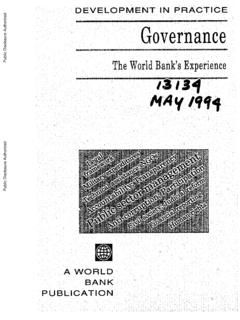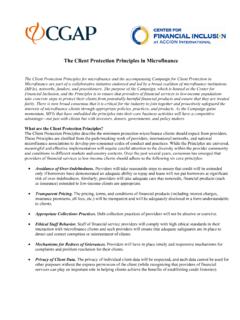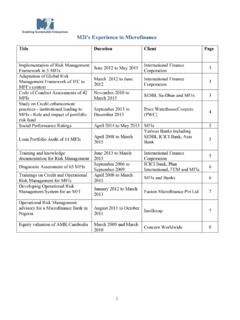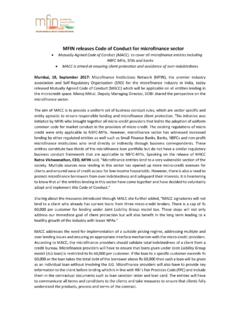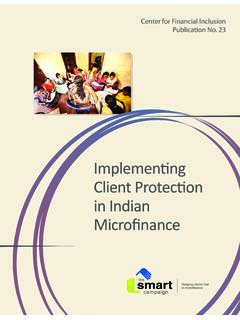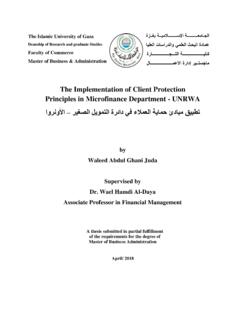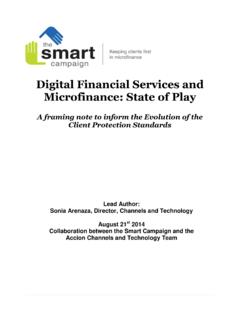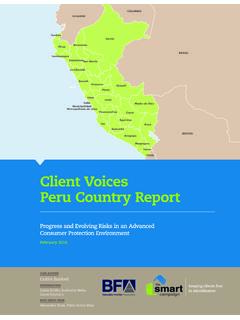Transcription of BRIEF the Client Protection Principles in Microfinance
1 Microfinance providers are now beginning to diagnose how they stack up against each principle and to experiment with how best to improve their products and processes, as needed. Given their role in building the Microfinance industry, investors can play a key role in this work, by supporting their partners and creating strong incentives for the industry to make progress. CGAP consulted widely across the investor community to develop the Technical Guide for Investors on Implementing the Client Protection Principles , which provides practical advice to diverse investors on how to integrate the Principles within every dimension of their Client Protection Principles have met with widespread support across the Microfinance industry. The challenge, however, is finding meaningful and practical ways for the hundreds of industry players that have endorsed the Principles to take action. This is particularly true for Microfinance providers, who are on the frontline of ensuring that clients receive appropriate products and treatment.
2 But it is also true for Microfinance associations, networks, and funders, since each can play a powerful role in accelerating the industry-wide process and supporting widespread uptake by providers. The Client Protection Principles are distilled from work over the past several years by providers, international networks, and national Microfinance associations to develop proconsumer codes of conduct and practices. They describe the basic fair treatment clients should expect from their financial services providers. Through discussion across the industry, consensus has emerged around the following six core Principles :Avoidance of Over-indebtedness Transparent Pricing Appropriate Collections Practices Ethical Staff Behavior Mechanisms for Redress of Grievances Privacy of Client Data The Technical Guide offers simple and straightforward guidance, tools, and resources for investors seeking to fully integrate Client Protection into their investment processes.
3 The Guide was compiled by CGAP, drawing on contributions from the Microfinance investor community. It presents seven recommended action steps, along with concrete examples of tools currently in use or being developed by investors and fund Implementing the Client Protection Principles in MicrofinanceJanuary 2010 BRIEFC lient Protection is a key tenet of microfi nance. The Client Protection Principles and the SMART Campaign1 are the heart of an industry-wide initiative aimed at safeguarding the interests of microfi nance clients . The end goal is adoption of appropriate policies, practices, and products by retail providers. By endorsing the six Principles and joining the Campaign, providers commit to take practical steps to treat clients fairly and respectfully while avoiding practices that might harm them. 1 Formerly the Campaign for Client Protection in Disclosure AuthorizedPublic Disclosure AuthorizedPublic Disclosure AuthorizedPublic Disclosure AuthorizedPublic Disclosure AuthorizedPublic Disclosure AuthorizedPublic Disclosure AuthorizedPublic Disclosure Authorized2 What is the purpose of the Guide?
4 Nearly 100 investors with a substantial engagement in Microfinance have endorsed the Principles and committed to help improve Client Protection in the industry. Endorsement signals that this issue is important to the investor, and that these six Principles deserve the attention of the field as a whole. Investor endorsement represents a commitment to work with their borrowers or investees on taking concrete steps, as well as building the Principles into their own investment processes investment policies, screening, due diligence, monitoring, reporting, and governance. The Guide is a tool to help turn this intent into should use the Guide? Microfinance investors are a diverse group, including public development finance institutions, small private equity funds, international Microfinance networks, and large commercial banks with small Microfinance units, among others. They have different business models, priorities, and institutional capacity.
5 While the Guide offers a comprehensive view of how the Principles are being implemented at present, it does not propose a one size fits all approach. Instead, it shares existing practice from diverse investors and fund managers, in the spirit of facilitating mutual learning and co-development of practices and standards in this nascent area over time. What are the recommendedactions for investors?The Guide starts by defining a minimum set of actions for investors that have committed to integrating the Principles into their investor processes: 1. Incorporate the Principles into investment policies. Recognizing the need for Client Protection is a critical first step. Board members and senior managers need to embrace the value of responsible finance and the case for stepped-up Client Protection , and leadership needs to communicate and discuss these issues with their staff. Raising awareness and mobilizing support from within is essential to create widespread buy-in and facilitate deeper implementation of the Endorse the Principles publicly.
6 A key step for an investment organization to demonstrate commitment to the Principles is public endorse-ment of the Principles of the SMART Campaign ( ). This signals the investor s view that Client Protection issues are part of doing good business. It also can provide an entry point for dialogue with partner Microfinance institutions (MFIs). In addition, endorsement helps build momentum and shared norms across the industry. 3. Encourage current and prospective investees to discuss and endorse the Principles . The next step is for investors to inform investee MFIs of their commitment. Encouraging investees to be active in the Campaign is important, as it will help accelerate progress on identifying specific improvements in policies and practices at the retail level that are both meaningful for clients and workable for the diverse array of Microfinance providers and contexts. Currently, most investors are not requiring current or prospective investees to join the Campaign and endorse the Principles .
7 Rather, most see the Principles at this stage as the basis for dialogue and building a shared understanding and approach to implementing the Principles over time. Given their ownership and sometimes governance roles, equity investors may take a more active role in ensuring the Principles are implemented, such as tabling the issue on 3 Board agendas and requiring management to monitor and report on implementation regularly to the Integrate Client Protection into screening and due diligence processes. Many investors are now designing, testing, and refining criteria and procedures for up-front assessment of current and prospective investees. Often, they are initially focusing on those Principles they find most important and/or that can be easily verified during due diligence. Some investors have issued guidelines to staff on evaluating whether a finance provider is responsible.
8 Investors that carry out due diligence in the field are translating the Principles into specific questions or indicators on MFI lending practices that can be verified through staff interviews and document checks. Many investors are referring to MIX s Client Protection checklist (question 8 in the new Social Performance Report) when developing their own indicators ( ). Investors also will find it very useful to review the Beyond Codes Self-Assessment Guide on Client Protection for MFIs (available at the Campaign Web site), which provides a comprehensive set of provider-level indicators for investors to consider in their due diligence Integrate the Principles into financing or shareholder agreements, as appropriate. Whether to integrate explicit provisions into the debt and equity documentation used by lenders and investors is subject to debate. Some wonder whether it is too soon to start including such provisions in financing documentation, given the early stage of implementation by providers.
9 Others question the scope and enforceability of such provisions. Most investors are focusing for now on the priority of gaining buy-in from the investee s management to start making the kinds of organizational changes required for improved Client Protection and fair treatment. However, a few investors have begun to include clauses expressly referring to the Principles in their financing agreements, while acknowledging that they may be open to interpretation and difficult to enforce. Their view is that this signals to the management of partner MFIs that they, as investors, take these issues seriously, they expect the investee s leadership to focus on identifying and implementing improvements, and they intend to monitor progress. 6. Monitor partners implementation of the Principles through mandatory reporting and regular monitoring and evaluation. Designing a system to monitor MFIs progress in implementing the Principles is an important part of investor oversight.
10 Monitoring processes will differ depending on the nature and capacity of the investor and partner. Investors that invest directly and carry out field-based due diligence are typically incorporating a review of Client Protection performance into the annual performance review. Others are designing surveys to gather MFI feedback on the state of implementation. Lessons from the Beyond Codes process will help investors determine which indicators are the most objective and broadly useful in assessing investees implementation of the Report on progress to investors and other stakeholders. The final step is for investors to report their commitment to and actions for implementing the Principles to their own shareholders and other stakeholders. With the financial crisis, many shareholders have increased their focus on the social performance of Microfinance and are asking that more information be support these recommended action steps, the Guide includes resources and tools that are currently being used by investors and fund managers.

